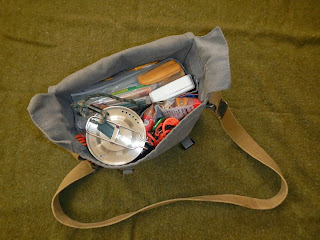My haversack...a surplus British military shoulder bag with a
Soviet M91 rifle sling for a strap. Very tough, solid canvas.
Haversack's are not designed nor intended to be used as a backpack, and they're definitely not intended for a heavy load. They're meant for carrying just a very few essential items, usually meal rations and little more. A more modern variation would be the "messenger bag" that became popular with bicycle messengers and was often seen on the TV action program "24".
In recent years, outdoors instructor Dave Canterbury [The Pathfinder School, LLC] has done much to re-introduce and promote traditional or "classic" bushcraft skills. Canterbury developed his "5 C's" concept of absolute minimal outdoors survival gear one should possess when a-trail: CORDAGE, a CUTTING tool, a COMBUSTION [firemaking] device, a COVER [sheltering material], and a CONTAINER [water gathering vessel]. Canterbury adopted the classic haversack as a means of carrying this minimal gear, and it can be seen in many of his earlier "Wilderness Outfitter" or "Pathfinder videos on YOUTUBE [ http://www.youtube.com/user/wildernessoutfitters ].
I occasionally use a haversack on those days when I want to travel light on a day hike. I would suggest that they are a good choice for the occasional or amateur hiker who doesn't want to buy a lot of gear, but only wishes to carry a few essentials for a comfortable hike, i.e., a bottle of water, some food, sunscreen, and a few other essentials. However I still suggest that even an amateur carry a few items necessary for surviving a cold night lost or injured on a trail. In the following photo's, I will share the contents of my own Haversack.
Contents of my Haversack
In the above photo, we see the contents of my haversack...In the TOP ROW are a sealed plastic bag with a lightweight emergency poncho [COVER or shelter], a Space Blanket, and chemical lightstick. I also have included a RITE IN RAIN notebook/pencil for making notes or sketching trail features for way finding, 100' bundle of 550 paracord [CORDAGE], a small First Aid kit, and a Flint & Steel kit and a candle with matches [COMBUSTION, or firemaking]. In the BOTTOM ROW I have my STANLEY cookset [CONTAINER for gathering water and ability to boil the water in order to disinfect it], a spork, a Swiss M71 jellied fuel stove, and some trail food items. The total weight of the pack is around 6 lbs., and is seen packed in the photograph below:
All kit items pack very nicely inside the haversack.
If you have paid close attention you will have noticed that I only mentioned four of Dave Canterbury's "5 C's of Survival". Some items should always be carried on your person at all times in case you become separated from your pack. Specifically, your knife [CUTTING tool] and a means of making fire. To that end, I carry a knife, either a fixed blade sheath knife or folder on my person and an additional means of making fire:
Always carry a knife and firemaking means on your person!
In the photograph above, we see a self made 2-twist lanyard with carabiner for attaching to my pants belt to prevent loss of my ferro rod and striker, and my matchsafe. I've also attached a spare blade, a tiny carabiner knife [a wonderful Holiday gift from youngest daughter Erin...made razor sharp after an hour or so re-profiling the blade on my stones] for picking splinters and performing small cutting chores.These items are then tucked deep into my pants pocket. Finally, I carry the excellent ESEE "ZANCUDO" folding knife from Randall Adventure Training [ http://eseeknives.com/index.html ].
It is always advisable to carry a canteen, which has a cap and is a secure means of carrying water. Once the water has been treated chemically or disinfected by boiling in a cookpot or vessel, it can be transferred to the canteen for consumption anytime you wish. I prefer a single-walled steel canteen or bottle that can also be placed over a fire to achieve a boil [CAUTION: LEAVE CANTEEN UNCORKED AND DO NOT USE DOUBLE-WALLED BOTTLES FOR BOILING...THEY CAN EXPLODE].
A handy tool to have is a spring steel "Fish Mouth Opener" hook, like the one shown here...it is compressed and placed inside the bottle and then released to suspend the bottle over a fire. It easily fits in the haversack:
KLEAN KANTEEN with hook manufactured by
HARDWOOD HOLLOW TACTICAL
You don't have to spend a lot of money either. Unlike a pricey new pack from a sporting goods store, the haversack I use was found at a garage sale and purchased for .50 cents. I later added an old canvas rifle sling for the carrying strap, which makes it handy for hanging from a limb off the damp ground:
My haversack. All I need for a day outing is
easily carried inside of it.
Surplus stores often have bags that can be modded into a haversack [Dave Canterbury has modded a n old USGI buttpack into a haversack by adding a shoulder strap]. Another option might be a castoff photographers bag.
There are also new commercially made haversacks or messenger bags available, some I've seen for as little as $20.00, and some like those made by CHROME cost much more. Either way, if you are considering hiking but don't want to carry a heavy pack, you might do well to consider carrying your trail essentials in a traditional haversack. Happy Hiking!
© 2014, MANNY SILVA, ALL RIGHTS RESERVED







Thank you for this great article. That is a nice looking kit you have there. I am currently working on a haversack kit to lighten my load, and the information you provided is very valuable.
ReplyDeletePerhaps a sit pad? I may be showing my age here!
ReplyDelete